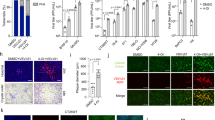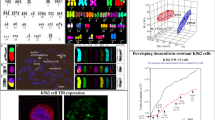Abstract
We have reported that the IL-2 Luc assay can detect the effects of chemicals on IL-2 promoter activity by using a dual reporter cell line, 2H4 cells that measure IL-2 promoter-driven luciferase activity (IL2LA) and GAPDH promoter-driven luciferase activity (GAPLA). Since the IL-2 Luc assay cannot detect immunosuppressive drugs that are antimitotic towards rapidly proliferating cells, we attempted to establish a new assay to detect these chemicals by taking advantage of the dual reporter cell properties of 2H4 cells. We first determined the optimal incubation time with drugs and the seeding cell density, and confirmed that the change in GAPLA and IL2LA levels reflects the change in cell count and IL-2 production of 2H4 cells after drug treatment. We designed the IL-2 luciferase lymphotoxicity test (IL-2 Luc LTT) to detect the antimitotic effects of chemicals by modifying the protocol and criteria of the IL-2 Luc assay. To determine the performance of the IL-2 Luc LTT and that of the combination of the IL-2 Luc LTT and the IL-2 Luc assay, we examined 46 drugs: 19 immunosuppressive drugs with different mechanisms of action, 12 anti-cancer drugs, and 15 non-immunosuppressive drugs. The performances of the IL-2 Luc LTT, the IL-2 Luc assay and their combination were 43.3%, 61.3%, and 93.3%, respectively, for sensitivity, 84.6%, 53.3%, and 50.0%, respectively, for specificity, and 55.8%, 58.7%, and 79.5%, respectively, for accuracy. These results demonstrated that the combination of these two assays is promising for the detection of immunosuppressive drugs with different mechanisms of action.






Similar content being viewed by others
Availability of data and material
All the data are available from the corresponding author.
Code availability
Not applicable.
References
Adler S, Basketter D, Creton S et al (2011) Alternative (non-animal) methods for cosmetics testing: current status and future prospects-2010. Arch Toxicol 85(5):367–485. https://doi.org/10.1007/s00204-011-0693-2
Barber RD, Harmer DW, Coleman RA, Clark BJ (2005) GAPDH as a housekeeping gene: analysis of GAPDH mRNA expression in a panel of 72 human tissues. Physiol Genom 21(3):389–395. https://doi.org/10.1152/physiolgenomics.00025.2005
Bradford K, Shih DQ (2011) Optimizing 6-mercaptopurine and azathioprine therapy in the management of inflammatory bowel disease. World J Gastroenterol 17(37):4166–4173. https://doi.org/10.3748/wjg.v17.i37.4166
Edwards DR, Denhardt DT (1985) A study of mitochondrial and nuclear transcription with cloned cDNA probes. Changes in the relative abundance of mitochondrial transcripts after stimulation of quiescent mouse fibroblasts. Exp Cell Res 157(1):127–143
Galbiati V, Mitjans M, Corsini E (2010) Present and future of in vitro immunotoxicology in drug development. J Immunotoxicol 7(4):255–267. https://doi.org/10.3109/1547691X.2010.509848
Gandhi V, Plunkett W (2002) Cellular and clinical pharmacology of fludarabine. Clin Pharmacokinet 41(2):93–103. https://doi.org/10.2165/00003088-200241020-00002
Gennari A, Ban M, Braun A et al (2005) The use of in vitro systems for evaluating immunotoxicity: the report and recommendations of an ECVAM workshop. J Immunotoxicol 2(2):61–83. https://doi.org/10.1080/15476910590965832
Haglund C, Aleskog A, Hakansson LD, Hoglund M, Jacobsson S, Larsson R, Lindhagen E (2010) The FMCA-GM assays, high throughput non-clonogenic alternatives to CFU-GM in preclinical hematotoxicity testing. Toxicol Lett 194(3):102–107. https://doi.org/10.1016/j.toxlet.2010.02.006
Kimura Y, Fujimura C, Ito Y, Takahashi T, Aiba S (2014) Evaluation of the Multi-ImmunoTox Assay composed of 3 human cytokine reporter cells by examining immunological effects of drugs. Toxicol in Vitro 28(5):759–768. https://doi.org/10.1016/j.tiv.2014.02.013
Kimura Y, Fujimura C, Ito Y et al (2015) Optimization of the IL-8 Luc assay as an in vitro test for skin sensitization. Toxicol in Vitro 29(7):1816–1830. https://doi.org/10.1016/j.tiv.2015.07.006
Kimura Y, Fujimura C, Ito Y, Takahashi T, Terui H, Aiba S (2018) Profiling the immunotoxicity of chemicals based on in vitro evaluation by a combination of the Multi-ImmunoTox assay and the IL-8 Luc assay. Arch Toxicol 92(6):2043–2054. https://doi.org/10.1007/s00204-018-2199-7
Kimura Y, Yasuno R, Watanabe M et al (2020) An international validation study of the IL-2 Luc assay for evaluating the potential immunotoxic effects of chemicals on T cells and a proposal for reference data for immunotoxic chemicals. Toxicol in Vitro 66:104832. https://doi.org/10.1016/j.tiv.2020.104832
Lankveld DP, Van Loveren H, Baken KA, Vandebriel RJ (2010) In vitro testing for direct immunotoxicity: state of the art. Methods Mol Biol 598:401–423. https://doi.org/10.1007/978-1-60761-401-2_26
Mori R, Wang Q, Danenberg KD, Pinski JK, Danenberg PV (2008) Both beta-actin and GAPDH are useful reference genes for normalization of quantitative RT-PCR in human FFPE tissue samples of prostate cancer. Prostate 68(14):1555–1560. https://doi.org/10.1002/pros.20815
Oliveira JG, Prados RZ, Guedes AC, Ferreira PC, Kroon EG (1999) The housekeeping gene glyceraldehyde-3-phosphate dehydrogenase is inappropriate as internal control in comparative studies between skin tissue and cultured skin fibroblasts using Northern blot analysis. Arch Dermatol Res 291(12):659–661
Pessina A, Albella B, Bayo M et al (2003) Application of the CFU-GM assay to predict acute drug-induced neutropenia: an international blind trial to validate a prediction model for the maximum tolerated dose (MTD) of myelosuppressive xenobiotics. Toxicol Sci 75(2):355–367. https://doi.org/10.1093/toxsci/kfg188
Rich IN, Hall KM (2005) Validation and development of a predictive paradigm for hemotoxicology using a multifunctional bioluminescence colony-forming proliferation assay. Toxical Sci 87(2):427–441. https://doi.org/10.1093/toxsci/kfi250
Saito R, Hirakawa S, Ohara H et al (2011) Nickel differentially regulates NFAT and NF-kappaB activation in T cell signaling. Toxicol Appl Pharmacol 254(3):245–255. https://doi.org/10.1016/j.taap.2011.04.017
Schmeits PC, Shao J, van der Krieken DA et al (2015) Successful validation of genomic biomarkers for human immunotoxicity in Jurkat T cells in vitro. J Appl Toxicol 35(7):831–841. https://doi.org/10.1002/jat.3079
Shao J, Katika MR, Schmeits PC et al (2013) Toxicogenomics-based identification of mechanisms for direct immunotoxicity. Toxicol Sci 135(2):328–346. https://doi.org/10.1093/toxsci/kft151
Shao J, Berger LF, Hendriksen PJ, Peijnenburg AA, van Loveren H, Volger OL (2014) Transcriptome-based functional classifiers for direct immunotoxicity. Arch Toxicol 88(3):673–689. https://doi.org/10.1007/s00204-013-1179-1
Shao J, Stout I, Hendriksen PJ, van Loveren H, Peijnenburg AA, Volger OL (2016a) Protein phosphorylation profiling identifies potential mechanisms for direct immunotoxicity. J Immunotoxicol 13(1):97–107. https://doi.org/10.3109/1547691X.2015.1016635
Shao J, Stout I, Volger OL, Hendriksen PJ, van Loveren H, Peijnenburg AA (2016b) Inhibition of CXCL12-mediated chemotaxis of Jurkat cells by direct immunotoxicants. Arch Toxicol 90(7):1685–1694. https://doi.org/10.1007/s00204-015-1585-7
Takahashi T, Kimura Y, Saito R et al (2011) An in vitro test to screen skin sensitizers using a stable THP-1-derived IL-8 reporter cell line, THP-G8. Toxicol Sci 124(2):359–369. https://doi.org/10.1093/toxsci/kfr237
Thellin O, Zorzi W, Lakaye B et al (1999) Housekeeping genes as internal standards: use and limits. J Biotechnol 75(2–3):291–295
Winer J, Jung CK, Shackel I, Williams PM (1999) Development and validation of real-time quantitative reverse transcriptase-polymerase chain reaction for monitoring gene expression in cardiac myocytes in vitro. Anal Biochem 270(1):41–49. https://doi.org/10.1006/abio.1999.4085
Acknowledgements
This study was supported by Grants-in-Aid from the Ministry of Economy, Trade and Industry (METI), Japan, the Ministry of Health, Labour and Welfare (MHLW), Japan, and the Japanese Society for Alternatives to Animal Experiments (JSAAE).
Funding
This study was supported by Grants-in-Aid from the Ministry of Economy, Trade and Industry (METI), Japan, the Ministry of Health, Labour and Welfare (MHLW), Japan, and the Japanese Society for Alternatives to Animal Experiments (JSAAE), Japan.
Author information
Authors and Affiliations
Contributions
All authors contributed to the study conception and design. Material preparation, data collection and analysis were performed by YK, HT, RA, TT, CF, and SA. YK and HT were equally contributed. The first draft of the manuscript was written by SA and all authors commented on the manuscript. All authors read and approved the final manuscript.
Corresponding author
Ethics declarations
Conflict of interest
The authors declare that they have no competing interests.
Ethics approval
Not applicable.
Consent to participate
Not applicable.
Consent for publication
Not applicable.
Additional information
Publisher's Note
Springer Nature remains neutral with regard to jurisdictional claims in published maps and institutional affiliations.
Supplementary Information
Below is the link to the electronic supplementary material.
Rights and permissions
About this article
Cite this article
Kimura, Y., Terui, H., Fujimura, C. et al. Optimization of the IL-2 Luc assay for immunosuppressive drugs: a novel in vitro immunotoxicity test with high sensitivity and predictivity. Arch Toxicol 95, 2755–2768 (2021). https://doi.org/10.1007/s00204-021-03101-4
Received:
Accepted:
Published:
Issue Date:
DOI: https://doi.org/10.1007/s00204-021-03101-4




